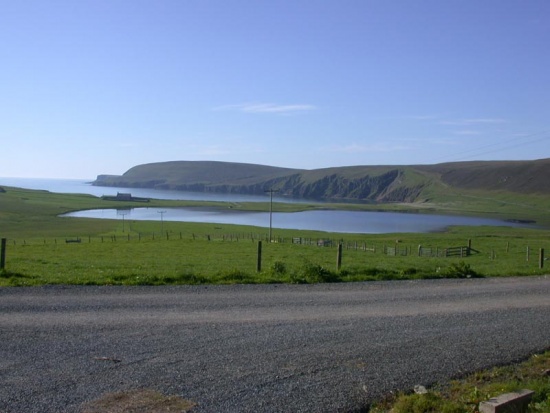| This article is incomplete. This article is missing one or more sections. You can help the BirdForum Opus by expanding it. |
Overview
Of the three inhabited north islands of Shetland, Fetlar is the smallest and greenest and lies south of Unst and east of Yell.
About one-sixth of the island forms the reserve but birds occur throughout. Much of the land is cultivated but there is peat moorland and blanket bog in the west and serpentine moorland, a very rare habitat in Britain. Found only on Fetlar,on neighbouring Unst, and in Cornwall, this type of moorland has characteristic, stunted herb-rich vegetation and grassy heathland with much exposed rock.
Birds
Notable Species
Birds of the moorland include Great Skua and Arctic Skua, Golden Plover and Dunlin, and nationally important numbers of Whimbrel. Other habitats found on the island are marshland and pools with Northern Lapwing, Common Redshank, Eurasian Curlew, Common Snipe, and careful management enables two-thirds of Britain's breeding Red-necked Phalarope to nest in the wetter marshes.
The rugged coastline has sheer and broken cliffs, shingle, rocky and sandy shores with breeding Northern Fulmar, European Storm-petrel and Manx Shearwater, Shag, Arctic Tern and Common Tern, Razorbill, Common Guillemot and Black Guillemot and Atlantic Puffin. European Herring Gull, Great Black-backed Gull and Lesser Black-backed Gull and Kittiwake also breed as well as Northern Raven, Hooded Crow, Rock Pipit, Twite and the Shetland subspecies of Wren.
Passage birds of a wide range of species occur in spring and autumn including large numbers of Redwing and Fieldfare in October.
Rarities
Rarities are frequently recorded and have included Nearctic vagrants such as Common Yellowthroat and Chestnut-sided Warbler. Waterfowl winter on Papil Water in the south of the island.
Fetlar is famous in ornithological circles for the Snowy Owl which bred here during the 1960s and 70s but although one or two birds are sometimes present, breeding has not taken place since 1975.
Check-list
Birds you can see here include:
Red-throated Diver, Northern Fulmar, Manx Shearwater, European Storm-petrel, European Shag, Common Eider, Eurasian Oystercatcher, Common Ringed Plover, Eurasian or European Golden Plover, Northern Lapwing, Dunlin, Common Snipe, Whimbrel, Eurasian Curlew, Common Redshank, Red-necked Phalarope, Great Skua, Arctic Skua, Lesser Black-backed Gull, European Herring Gull, Great Black-backed Gull, Black-legged Kittiwake, Common Tern, Arctic Tern, Common Guillemot, Razorbill, Black Guillemot, Atlantic Puffin, Snowy Owl, Rock Pipit, Shetland Wren, Fieldfare, Redwing, Hooded Crow, Northern Raven, Twite
Other Wildlife
Mammals are few but there is a thriving population of Otters and Common Seals and a large Grey Seal colony, as well as Hedgehog and Rabbit, House Mouse and Field Mouse.
Site Information
History and Use
To do
Areas of Interest
Loch of Funzie in the east of Fetlar is the best place for the phalaropes. Other breeding waders include Oystercatcher and Ringed Plover and Common Eider and Red-throated Diver breed on the lochs. Map
Grid reference: HU655900
Access and Facilities
Fetlar can be reached by car-ferry from Unst or Yell, which is best booked in advance. The reserve is open all year but during the summer visits can only be made by arrangement with the warden who will escort parties.
Contact Details
Tel: 01957 733246 (RSPB)
External Links
Reviews
Originally posted by peterct1945 June 2004: I had heard that one could watch this charming little wader through the window of your car, but I didn't believe it! As soon as I had parked by the Loch a flurry of birds flew around us very closely. They settled on the loch picking at impossible small invisible prey of the water surface. They were very approachable allowing excellent viewing without binoculars. At least 6 birds were present and possibly twice that number; a pair of red-throated divers were also there.
Content and images originally posted by Steve






